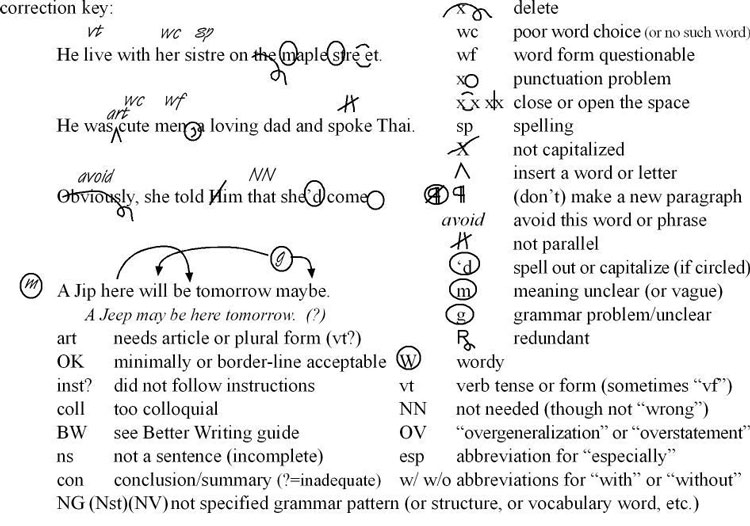Correction Key
(These are the symbols
I use in correcting student work.)

Writing Grade Scale (total of 10 points)
FIRST DRAFTS may be graded more
leniently than revisions (I allow more-or-less double the number of
problems).
LANGUAGE (grammar, spelling, punctuation, word choice or form, etc.)
6=perfect (no errors) (on drafts, I may allow one minor error)
5=less than five language errors
4=less than ten language errors
3=ten to fourteen (I may not take the time to mark all of these errors)
2=fifteen or more errors (I may not take the time to mark all of these
errors)
1=extremely poor English (usually due to lack of editing or peer help)
(I won’t mark them all)
NOTE: a “Language” mark deals with mechanics, not content. Your content
may be very good even if you get a “2.” Likewise, an essay with good
content may get a low “Content” grade if it has many other problems. I
may count double for errors I corrected or marked on your draft (or
specifically covered in class), but which you did not correct on the
final paper. A draft with a perfect “10” lets you write about anything
you like instead of doing a revision (less than 200 words).
CONTENT (structure, clarity, following directions, meaning, creative
expression, etc.)
4 points = good structure as required by the assignment; convey
information clearly; appropriate length; interesting content. Essays may
lose points for poor or inappropriate conclusion (or if conc. doesn’t
name the subject when needed), lack of clarity or creativity when
needed, not double-spaced or typed/formatted correctly, word count (too
many, too few, or not counted), no date (or name) written on the top,
Chinglish, fluff, wordiness, redundancy, “meaning unclear,” lack of
noticeable effort, no or poor title, failure to follow instructions
(including bad punctuation in your heading/name, and if you type DO NOT
justify!), etc. Note that hand-written corrections are fine on your
draft, but if you have more than one on your final copy you will lose a
point (so have your peer-reader look at it BEFORE you print the final
copy). Style and a polished presentation are important parts of learning
to write.
Your work will automatically lose half of the possible points if the
“original” is not attached to a revision (so keep ALL originals where
you can find them!!). I usually give a zero to nameless papers.
Automatic zero (on both the draft and revision) if you plagiarize (or
have too close a resemblance with another student’s paper), AND minus 30
on your final exam score—you will also have to talk to a Chinese teacher
about this. If it happens twice you can no longer attend, and you fail
the course.

Note to teachers:
Using codes like the ones shown here can help reduce the time spent
grading essays. In general, when I write a code near student mistakes
I do not specifically correct the errors. This encourages the student
to think about the problem and/or ask for help if needed (from me or a
peer). If there is a good chance that the student and his/her
classmates can not figure out the correction on their own, I may
correct the error myself. I am also more likely to make the
corrections on revisions than on first drafts. To encourage peer
editing, I require students to have a classmate read each essay before
it is turned in to me. (See additional notes at the bottom of my
"types of writing" handout.)
I don't remember how or when this code list started. I have seen many
similar lists. Feel free to adapt it to your own needs.
This resource was created for our students under my
understanding of "fair use" for educational resources.
© 2007 Michael Krigline, all
rights reserved. As far as I am concerned, people are allowed to print/copy
it for personal or classroom use.
(see Website Standards and Use Policy)
